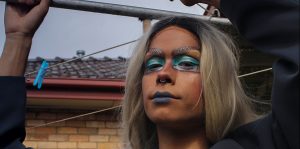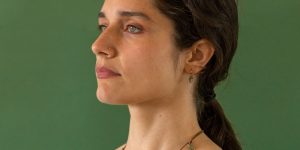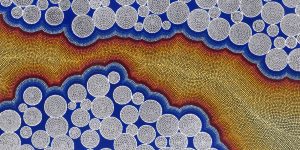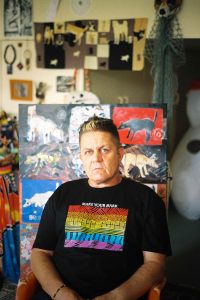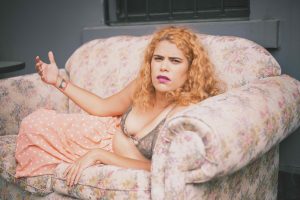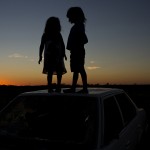Queer and Aboriginal in a regional setting: Identity and place
By: Andrew Farrell

The interplay of identity and place is fresh in my mind after re-reading Bronwyn Fredericks’ ‘We don’t leave our identities at the city limits’ (2013). In this article, she argues that space and place are never neutral in the sense that there is an ongoing cultural, social and political struggle at play.
This was also highlighted by my PhD supervisor, Professor Bronwyn Carlson, in a radio interview discussing the legacy of colonialism found in the physical landscape.
Drawing on these discussions, I began to think about how my experiences have been shaped by the spatial absence of queer Aboriginal peoples in regional Aboriginal communities.
This sensitive topic draws attention to the replication of unequal power relations between queer and non-queer Indigenous peoples, highlighting fractures within oppressed groups in place of the broader binary of the coloniser and colonised.
I am an Aboriginal person from the south-east coastal region of NSW. This area is also known by Indigenous peoples as a part of the Yuin nation. I do not identify with the Yuin nation, but others in my community do.
Growing up, I identified, and still do, with the Aboriginal community I belong to: Jerrinja.
This does not mean I do not support terms such as ‘Yuin’ as having significance across communities in my region. I do not typically identify with Yuin as its symbolism is not transferable to my ties to Jerrinja, which have so deeply characterised my identity and the physical, social and cultural spaces that constitute my experience of community.
Variant tribal affiliations including Tharawal/Dharawal, Wodi Wodi and Yuin function to reconstitute boundaries of identity and country. Locals often evoke these words in the context of formal community meetings.
As a young child I remember hearing these words while playing, as a land council meeting took place in what was formerly known as the Roseby Park school – an institution in mission boundaries where the community endured generations of an enforced Western, Catholic and Christian education.
The significance of community organising happening on these grounds did not really occur to me as a child. It has taken years of learning to understand that the community meetings were more than just ways to organise and administrate community space. They were actively performing their reclamation of land by rejecting its colonial ties.
This is important to us as sovereign peoples in an area that has one of the longest histories of contact between Indigenous and non-Indigenous peoples since 1788.
The dispossession of our cultural practices and identity aligns closely with the colonising of place and space. Indigenous peoples across the continent were denied their sovereignty from the outset with the claim of terra nullius, and quarantined by paternalistic and eugenics-based policies that assured society we would die out.
When we survived, a renewed push came to integrate us into the nation so our culture would dissolve over time.
On the south coast, my people were pushed out onto the fringes of society and our nation’s boundaries were eroded. My community was placed out of sight by settlers with the establishment of the Roseby Park Aboriginal Reserve in 1900, which we now call Jerrinja Aboriginal Community.
A local news article in the Shoalhaven Advertiser in 1900 describes an appeal to move the community of Aboriginal people at Seven Mile Beach to more suitable areas as their current habitation of the region was deemed unsuitable by local community groups.
These demands were put into action by the Aborigines Protection Board, who also established one of the most insidious institutions in our region and state, the Bomaderry children’s home.
Our recovery from this history includes notable achievements, such as the handing over of the Roseby Park Reserve to the community in 1978, pre-dating the 1983 New South Wales Land Rights Act.
My community has also actively resisted nuclear facilities and military occupation in the 1980s, and were accounted for in the Sydney bicentennial protests in my birth year, 1988.
Jerrinja would not exist without the activism of community, including our LGBTIQ+ relatives. My history and trajectory are shaped by this long history and help me to understand the effects of engaging in sites of struggle. I like to think that this has imbued my identity with a sense of justice that is community oriented, and sensitive to the perpetuation of colonising forces as they arise.
The legacy of my community’s staunch political activism is visible in the infrastructure emerging in our community. This includes a facility that serves the community as, among other things, a medical centre.
The building sits at the main entrance of the community and is distinctly Indigenous, with familiar designs of animals in dot motifs. It is actively utilised by the community, as it was when it first opened in the mid 2000s.
The medical centre runs community workshops and provides a gateway to medical care beyond the space, including an outreach medical service run by the South Coast Medical Service Aboriginal Corporation, which is an Aboriginal community-controlled health organisation located in Nowra, NSW.
Our dependence on these services reflects continuing difficulties in accessing health and wellbeing services, regardless of the misconception that Aboriginal people have access to all the privileges associated with living in the wealthiest corner of the continent.
I have a lot of nostalgia tied to the medical centre. Prior to its establishment, I remember feeling intimidated by the quiet, musty, brown office of my local GP on Silvermere Street. The aged reception room was, in many ways, culturally foreign.
Jerrinja’s new medical facility fulfilled the need for a culturally appropriate space which reframed these experiences as well as shaping the requirements for culturally appropriate practices by medical doctors and health workers.
The medical centre is always decorated with health promotion resources in the form of posters, pamphlets, stickers, badges and condoms, and we all had playful yarns about who took them and what they were doing with them.
Every noticeboard is filled with posters on smoking, alcohol and a litany of health concerns illustrated with Aboriginal and Torres Strait Islander peoples and flags. This sensory overload of materials reinforces the cultural space by territorialising representations of health and wellbeing.
My relationship to community and these organisations has changed as social fractures have occurred. My gender and sexual identity, and the associated health and wellbeing needs, meant that I wouldn’t and couldn’t access these spaces, nor were there connections to services I could seek out.
As an adolescent I was afraid of where I would end up, and I was particularly scared of the risks I would have to take to be who I am. I was vulnerable and isolated in my community due to my queer growing pains.
My boy troubles were not just about crushes and affection; they were also issues about being male. Through these ambiguities and my shifting relationships, I became hyper-aware of the ways that I didn’t fit in, and distressed by the fact that I couldn’t openly figure things out with my own mob.
Although I do not live on country today I am still connected to my community in many ways. I see what’s ahead on community pages on Facebook, through relatives who work in community, as well as via the social grapevine.
Through these connections, I am able to maintain a critical eye on the challenges that our queer mob face in community. In my region, the running of men and women’s groups is in some ways problematic and normative, as these programs are sometimes exclusionary and alienating for LGBTIQ+ people who want to participate.
From that position, I am aware of the ways normative gender and sexual practices take authority in the space. When that authority has a disregard for particular people in the community, it results in mob who are not counted and not cared for.
My community is not special in this regard. There is a widespread failure to facilitate LGBTIQ+ inclusion. Broader regional medical services are significantly more challenging to navigate for both the Aboriginal and LGBTIQ+ communities, let alone queer Indigenous peoples. This is why it is vital that community lead the way.
Physical and emotional dislocation is a common narrative in current media representations of queer Indigenous experiences, in which Indigenous LGBTIQ+ peoples express fraught relationships with home.
We frequently seek out safer queer and Indigenous spaces and undertake the process of physical relocation, often to urban centres. We also navigate relationships with local Indigenous communities while contending with spaces and places claimed by settler queer peoples.
Aligning with these narratives of relocation, I originally moved from community to seek a space to, for lack of a more nuanced description, be myself. Being myself goes beyond identifying as queer. I want to explore gender and not experience violence, alienation and isolation.
I also want that space to be safe to be Aboriginal and free of gender and sexual requirements that are used to authenticate my Indigeneity. Most of all, I want to live a queer Indigenous life on my traditional homeland.
While struggling with eventual dislocation from community, I have found a sense of purpose by pushing boundaries and claiming space in academia.
After moving to Wollongong and beginning undergraduate courses at the University of Wollongong, I met Professor Carlson, who became my PhD supervisor. Her leadership, proactive solidarity and acceptance of LGBTIQ+ Indigenous peoples has in many ways permitted me to challenge Indigenous Studies and build interdisciplinary challenges to the broader university landscape.
Professor Carlson is now Head of Department and I am an academic fellow working on the unceded lands of the Wattamattagal clan of the Darug nation claimed by Macquarie University.
The Indigenous Studies Unit has forwarded a vision to revitalise and innovate Indigenous Studies at Macquarie through new curriculum and research. These developments are situated within a longstanding institution named after a settler whose role in early colonies involved military strikes against Aboriginal peoples including the Appin massacre.
By acknowledging this problematic juncture, we continue to name and resist silence and exclusion to better reflect and accommodate our vision so that both Aboriginal and LGBTIQ+ people may be able to navigate a space which is largely recognised and criticised as unwelcome to both.
We are unapologetically proud and inclusive, and aim to materialise those values in our place within the institution as a beacon for Indigenous LGBTIQ+ peoples both nationally and globally.
I am a part of the academic staff and a doctoral student. My thesis is on Indigenous LGBTIQ+ communities online. I am working on multiple research projects, doing a thesis by publication, and developing new courses.
My team is developing an Introduction to Indigenous Queer Studies course (ABST1030), in which I and other Indigenous LGBTIQ+ scholars will articulate the historical and current experiences of Indigenous LGBTIQ+ peoples. It is the first course of its kind in Australia and will be available through Open Universities Australia beginning in 2020.
Across the semester we will investigate the complex and layered gendered, sexual and racial dimensions of prevalent social issues.
One of my many aims with this course is to boost the literacy of students who will potentially work with and for Indigenous peoples in any capacity. Assignments, lectures and tutorials are built to provoke critical awareness and demonstrate sensitivities to our diverse communities. It will have an impact and hold currency outside of the university space as a skill set.
I have found this to be already true as students reflect on the ways that Indigenous Studies helps them in their current workplaces. Within the framework of cultural diversity, there must be a recognition of gender and sexual diversity. ABST1030 addresses that.
Beyond teaching, I am also involved in projects around social media, interpersonal relationships, online safety and violence. Through these projects, our unit has created visual resources that introduce communities to the issue of online violence, safety and inclusion.
These are materials that can be displayed in medical and community centres, and are designed and marketed specifically for Indigenous organisations and audiences. Through collaborative design, these posters introduce community to the prevalence of LGBTIQ+ violence online.
They will undertake a journey in which they will be displayed, rejected, vandalised and torn. On the optimistic side, they will be seen, provoke a discussion, and have longevity on the walls of these spaces.
This project ultimately aims to highlight the experience of LGBTIQ+ Indigenous peoples in relation to place and space between community, community services and the digital terrain where LGBTIQ+ Indigenous peoples experience complex positions as insiders and outsiders, included and excluded, visible and invisible.
At a time when we are discussing treaty, voice and truth-telling processes, it is important that Aboriginal and Torres Strait Islander peoples are critical of diversity, autonomy and inclusion.
Bringing to light struggles of queer diversity is complex, both between Indigenous and colonial nation states and between and across Indigenous peoples. These sites are struggles of colonial gender and sexual norms which must be understood and interrogated for our Indigenous LGBTIQ+ community to feel that we matter and belong.
Diversity work is messy, no doubt, but inclusive and culturally autonomous coalition-building is essential for future Indigenous advancement.
What is important to me is that cultural spaces adapt where it is vital for the wellbeing of our marginalised and oppressed. These discussions become more accessible when our physical space provides us with an opportunity to mediate unspoken tensions.
It does take a lot more than posters to bring about inclusion and acceptance, but these material objects and their display can hold power in a path of articulation.
Andrew Farrell is a Indigenous Early Career Academic Fellow in the Department for Indigenous Studies, Macquarie University. Andrew is a Wodi Wodi descendant from Jerrinja Aboriginal community on the South Coast of NSW. His research is multidisciplinary with a focus on Aboriginal LGBTIQ+ gender and sexualities, media and online studies, and drag performance. Andrew is also undertaking a PhD project titled ‘Aboriginal LGBTIQ peoples online’.
This article first appeared in Archer Magazine #13, the FIRST NATIONS issue. SUBSCRIBE TO ARCHER MAGAZINE




